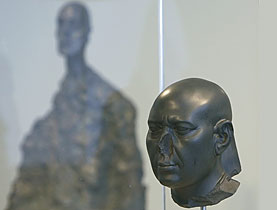Giacometti and his Geneva crisis

The career of Alberto Giacometti, the leading Swiss artist of the 20th century, was punctuated by creative crises - not least during his time in Geneva.
A major retrospective, with a special focus on his little-known Geneva period (1941-1946), is on show at Geneva’s Rath Museum.
The exhibition, which spans his entire career, puts the spotlight on the 1935-1946 transitional period from his Surrealist objects to the slender, elongated figures he produced after the war.
At the time Giacometti underwent one of the longest and most intense creative blocks of his artistic career.
The Rath show is the first important retrospective of his work in French-speaking Switzerland and comprises over 70 sculptures, 20 paintings, as well as objects, drawings, notebooks and photographs. Two rooms are devoted to his Geneva period.
Early years
Born in the tiny village of Borgonovo in eastern Switzerland in 1901, Giacometti chose Paris as his city of adoption.
But throughout his life he maintained close ties with Geneva. He applied to attend the Geneva School of Fine Arts on the advice of his father Giovanni Giacometti, a well-known Post-Impressionist painter.
Alberto visited Geneva in 1919 but neither the school nor the town appealed to him so he stayed only a few months.
When he left Paris to visit his mother in Geneva some 20 years later, little did he know that he would end up living there from 1942 to 1945. At the time he was not authorised to return to France due to his Swiss nationality.
The period from 1935-1946 proved to be a difficult one for Alberto. Not only was it wartime, but he was also undergoing one of the longest and deepest crises of his artistic career.
Critical transition period
“It’s a real transition period between his Surrealist objects and his mature works which are well known, such as Man Walking or Woman Standing,” Nadia Schneider, curator of the retrospective, told swissinfo.ch.
This decade of crisis turned out to be a critical juncture and a building block for his creative process.
“This transitional period was a major rupture in his career,” said Schneider. “He loses all contact with galleries and doesn’t show his work. But it’s a period when he questions his work and tries to find a new way of looking and translating what he sees.”
Giacometti’s difficulties began when he turned away from an avant-garde style at the end of 1934 to bring the human form back to centre of his work. His figurative approach to depicting heads eventually resulted in his excommunication from Surrealist circles.
Smaller and smaller
During this period his work also started to reduce in size, reflecting his attempt to represent bodies and heads according to how he saw them at a distance.
“I saw nothing but countless details. To see the whole I had to push the model further and further back. The more distant the head, the more it shrank in size, something that terrorised me,” Alberto commented.
This gradual reduction in size can be seen in the drawings of his young nephew Silvio on display at the Rath Museum, as well as the bust of his dead sister Ottilia.
While in Geneva, Giacometti worked all day and often nights sculpting heads and figurines in his room at the Hotel de Rive.
But he was frequently frustrated with his attempts to render the impression of a figure as seen from afar.
“A large figure appeared wrong to me, while a small one was intolerable, and then they became so minuscule that with a final cut of the knife they often disappeared into the dust,” said Alberto.
The few surviving busts or tiny figurines from these years are on display in Geneva set on huge bases to accentuate their small size.
Unblocked
It was only after his return to Paris in September 1945 that Giacometti managed to sort out his creative problems. His artistic block was partly resolved by Annette Arm, who he met in Geneva in 1943. She followed him to Paris to work as his favourite model and later became his wife.
The exhibition shows one of his pivotal creations from 1946, Projet de Monument pour Gabriel Péri, which recalls his Surrealist sculpture projects for public squares in the 1930s. But at the same time it indicates his way forward – an emblematic figure of a walking man is seen for the first time.
The museum basement is dedicated to Giacometti’s better-known mature period, with pieces such as Walking Man (1947), The Nose (1947) and The Chariot (1950), as well as later sculptures like the various busts and heads of his brother Diego and the paintings of his mother, Annette, and Japanese model Isaku Yanaihara.
Although this part of the exhibition does not touch on his artistic crises, the notion remained a fundamental part of his work. His creative path was never a straight one.
Positive failures
Even during his most productive years, he would destroy most of his work, dissatisfied with the results. But these crises allowed him to recognise the importance of failure as a key driving force of his creative process.
“It isn’t in order to realise a vision that I have things to work on, but to understand why they don’t pan out. The idea of making a painting or a sculpture of the object as I see it no longer even occurs to me. What I want is to understand why it doesn’t work. And the failure becomes at the same time a positive thing,” he said.
Today, Alberto Giacometti is Switzerland’s most important artist internationally. His work is highly prized – his Grande femme debout (Tall woman standing II) sold for $27.5 million (SFr29 million) in New York last year, confirming him as the most expensive artist.
Giacometti is both an atypical and typical example of a modern artist, said Schneider, explaining his attraction.
“In 20th-century art history, abstraction is the model for most artistic work. But Giacometti goes back to figurative work in 1935 and sticks with this to the end of his life. That’s quite unusual,” she said.
“He’s also the image of a genius artist as many people might imagine: a struggling artist searching deep for new things.”
Simon Bradley in Geneva, swissinfo.ch
The display runs from November 5, 2009 until February 21, 2010 at the Musée Rath in Geneva.
It comprises over 70 sculptures, 20 paintings, as well as objects, drawings, notebooks and photographs by Alberto Giacometti, with special focus on the 1941-1945 period when he stayed in Geneva.
Around half of the works come from the Alberto Giacometti Foundation in Zurich. Other loans, many for the first time, are from institutions and private individuals.
The Rath Museum retrospective follows a series of exhibitions on the works of Alberto and his artistic family in Switzerland (Bern, Basel, Geneva and Zurich).
Giacometti was born in the small village of Borgonovo, in canton Graubünden in 1901.
Encouraged by his family, he began to draw and sculpt at a very young age. After attending college, he decided to study art, first in Geneva, then in Paris.
He came into contact with the major artists and intellectuals of the period, experimenting with Cubism, Surrealism and by the mid-1930s had rekindled an interest in drawing the human figure.
Giacometti continued to hone his craft from 1937-47, with some of his sculptures reducing in size to the point that, according to legend, he could carry them in matchboxes.
The figures from this period, such as Walking Man, are probably Giacometti’s best-known works. They later regained a sense of volume.
Giacometti was also producing paintings, drawings and writings.
He became increasingly well-known in the mid-1950s, with his art going on show in Europe and the US, but still he continued to live and work in Paris.
In the early 1960s, his health began to suffer from his irregular lifestyle and overwork. He died in January 1966 and was buried in the village of his birth.

In compliance with the JTI standards
More: SWI swissinfo.ch certified by the Journalism Trust Initiative













You can find an overview of ongoing debates with our journalists here . Please join us!
If you want to start a conversation about a topic raised in this article or want to report factual errors, email us at english@swissinfo.ch.